Customer service, by default, revolves around the traditional concept of helping customers when they show up with a problem.
There is nothing wrong with this approach except the fact that customers have to go through the frustrating process of emails and calls every time they encounter challenges.
Is this reactionary approach sufficient in today’s intensely competitive climate?
Absolutely, No!
Today’s customers need much more than mere handholding through the problem-solving process. They need you to anticipate issues and proactively resolve them before they turn into real problems.
That’s what proactive customer service is all about – helping customers even before they know they need help!
Don’t we feel at ease when we get quick updates about an outage in a video streaming service well in advance? Saves us from all the frustration later!
Don’t we feel satisfied when a company representative calls to inform us about a delay in Pizza delivery before we find it out ourselves? Keeps the cravings in control!
If you want to walk down this path and build strong customer relationships, this blog has got you covered. Dive in and explore 9 proven tips to implement proactive customer service successfully.
Let’s go.
What is Proactive Customer Service?
Proactive customer service is about always staying one step ahead by solving problems even before customers know they have them. This means you anticipate issues and provide a solution before they escalate into big problems.
Proactive customer support puts customers front and center across all touchpoints to build strong relationships that last a lifetime.
A common example of this type of customer service would be a restaurant server re-filling a customer’s glass of water even before he is asked to do so.
Another example would be an e-commerce company informing customers about a delay in delivery and explaining the reasons. This saves customers from all the inconvenience of contacting the support staff and waiting for a response.
Proactive & Reactive Customer Service – What is the Difference?
Just like their names, proactive and reactive customer service are completely different from each other. Let’s learn how.
Proactive Customer Service –
A proactive approach to customer engagement requires businesses to make the first move. You’ve to anticipate customer needs and issues and deliver the required solution.
Reactive Customer Service –
On the contrary, reactive customer service is about providing a solution after a problem has already occurred. It’s like trying to use fire after the flames have done all the damage.

Now, here’s the question, which one is better for customer onboarding and support – proactive or reactive customer service?
Proactive customer service is a clear winner as it gives you the power to not only predict problems but also act on them before they turn into blunders. Here, you put customers’ convenience before everything else and offer delightful experiences at every step.
Why is Proactive Customer Service the Need of the Hour?
With customers turning more and more demanding, the importance of proactive support has increased. With a proactive mindset, you can plan solutions in advance and always stay ahead of the game.
Here are the top benefits you can glean from proactive customer engagement:
Boosts Customer Loyalty & Retention
In an age when customers are spoilt for choice, it’s difficult for them to stay loyal to a brand. Every time they see a better option, they would want to make a switch.
Proactive customer service helps you offer support to customers even before they know they need it. Solving pain points that customers are not even aware of makes them feel valued and cared for. When customers realize you genuinely care about them, they will stick to you through thick and thin.
Research reveals that 96% of customers consider customer service as an important factor in their loyalty toward a brand. So, if you go proactive with your customer service, it’s definitely going to leave a positive impact on customers, boosting loyalty and retention.
Prevents Minor Problems from Escalating
Minor issues can easily transform into bigger problems if not dealt with on time. With a proactive approach, you can nip minor problems in the bud and prevent them from growing into frustration-inducing pain points.
For example, by proactively informing customers about delayed delivery and explaining the reasons, you can help them stay reasonable with their expectations and prevent the situation from worsening.
Gives Your Agents Room to Breathe
A reactionary approach to customer service is likely to bury your agents under an avalanche of support tickets. On the other hand, the proactive approach anticipates and solves issues well on time, preventing unnecessary escalations.
This reduces the number of tickets reaching your customer support team, giving them ample time to focus on bigger problems that need their undivided attention. Furthermore, this also helps agents be their productive best at work.
Reduces Customer Frustration
When a minor issue aggravates into an unavoidable problem, customers have no choice but to contact you for help. And then the never-ending cycle of calls and emails begins.
Engaging with customers proactively prevents such situations from arising in the first place.
For example, with a self-service help center in place, customers can quickly solve basic problems and save themselves from the frustration-inducing process of emails and calls.
While this keeps customers satisfied, this gives agents the time to attend to other serious matters.
Now that you have learned about the benefits of proactive customer service let’s explore some powerful strategies that can help you achieve these benefits.
Practical Tips to be Successful in Proactive Customer Service
It’s finally time for the main event. Let’s now explore 9 proven tips to achieve sure-shot success in proactive customer service.
Understand Your Customers to the Core
Knowing your customers inside out sets a solid foundation for proactive customer communication. When you have a clear idea of their demographics, expectations, needs, and preferences, you can easily predict their pain points and address them.
So, how can you get into your customers’ heads and identify what they really want?
There are multiple ways you can do that.
For example, you can create market research surveys and customer experience surveys to learn about customers’ interests, what they like and what they don’t. With the right data at your disposal, you can spot potential problems and take timely steps to resolve them.
You can also track their conversations in discussion forums to find out problematic areas and fix them on time. Social media is another platform where customers actively engage with brands and divulge important information. Tap into such platforms and gain deeper insights into what your customers really want.
Promote Self-Service to Provide Prompt Solutions
There is a popular saying, “Self-service is the best service.”
Have you ever wondered why?
Self-service is considered one of the most convenient routes for customers to get what they need. It’s flexible, empowering, and, most importantly, time-saving.
These are some of the major reasons why 88% of customers across the globe expect brands to deploy a customer self-service portal.

Such a 24×7 accessible information resource takes help closer to your customers, right where they are, making problem-solving a matter of a few clicks.
Now, you may have a help center, but the question is – is it really serving the purpose of proactively helping customers?
If yes, you should be receiving fewer tickets. But if the answer is no, you can follow these simple tips to turn your customer service knowledge base into a useful information resource:
- Make it accessible across mobile phones, tablets, and laptops
- Develop a solid search system that returns topic-relevant results
- Optimize your help center for search engines and make it easy to discover
These simple tips will help you create a compelling help center that will never fail to answer customer questions.
And if you need more assistance, here’s a short video to guide you through the process of building an online help center with knowledge base software.
Stay Connected to Customers With Chatbots
Embracing automation in the form of chatbots is one of the most beneficial proactive customer service strategies you must adopt today.
No matter how much you try, you can’t be present for your customers round the clock. More so when your customer base is diversified across the globe. That’s when catering to their unique needs gets all the more challenging.
Today’s sophisticated chatbots are known to stay one step ahead of customers. They can quickly detect customers’ problems by tracking their browsing behavior. This helps chatbots throw the right questions, supply accurate resources, and offer real-time assistance.
In instances where the questions are complex, chatbots transfer chats to suitable operators for timely resolution.
Quick prompts, intelligent routing, and automated ticket creation are some of the key features of chatbots that give you the power to proactively attend to customer requests.
As chatbots are equipped with such cutting-edge capabilities, they can solve around 80% of standard customer questions, according to research by IBM.

If you are wondering how to set up a chatbot for your website, this video has got all the help you need.
Proactively Ask for Customer Feedback
While some customers express their feelings and opinions explicitly, others simply leave with their problems remaining unspoken and unresolved.
Research reveals that a whopping 91% of customers who do not complain tend to leave a business for better pursuits.

So, how can you prevent customers from taking such drastic steps and be more open to sharing how they feel?
By proactively taking feedback, making them feel they are integral to your business, and most importantly, acting immediately on their concerns.
That being said, not all customer feedback is worth attending to. You need to work with an open mindset and be accepting of every customer’s feedback. But, at the same time, you must know which feedback deserves your time and attention.
Proactively seeking feedback will urge customers to voice their concerns. That’s when they get the reassurance that their concerns will not go unnoticed.
Now, here’s the question, how to capture customer feedback and deliver proactive customer service?
You can create surveys and share them after every customer interaction.
For example, once a ticket is resolved, share a short survey with customers asking them to rate their experience. You can even share NPS surveys with customers to identify brand loyals as well as detractors.
Once you gather the feedback, decode it to spot trends and find improvement areas. Modern survey tools, such as ProProfs Survey Maker comes with robust reporting capabilities that allow you to analyze the survey responses and make informed decisions for customer success.
If you want to create surveys but don’t know where to start, this video will offer all the guidance you need.
Monitor Customer Conversations on Social Media
Customers talk about your brand in private with their friends and family, but they also share their experiences with the public on social media.
There are two key reasons behind sharing experiences on social media:
- Customers are extremely happy with a brand and can’t contain their excitement
- Customers are so frustrated that they need a platform to vent out and give the brand a good lesson to learn
Good or bad, anything shared on social media spreads faster than wildfire.
However, social media is also the platform that opens the door for you to better understand customers’ needs and preferences. You can follow brand-related keywords and hashtags to track customer conversations and brand mentions.
This way, you can keep a close watch on what your customers are up to and stay actively involved in their conversations.
For example, if there is wrong news being spread about your company, you can immediately take notice and clear the confusion. When customers share their disappointment over the delivery time or a faulty product, you can pitch in proactively and prevent situations from worsening.
Such proactiveness on social media will put your brand in a favorable light and boost customer loyalty.

Own Your Mistakes
There are 2 ways to look at mistakes. You can either keep whining and continue repeating the same mistakes. Or, you can take responsibility for your mistakes and do positive self-talk –
“We did something wrong, and we are going to mend it.”
When you own up to something, apologize, and take immediate action, you can turn around the entire situation. Customers will appreciate your honesty, and you can grab a place in their good books forever.
However, it’s easier said than done. Being honest about shortcomings and mistakes is not for the faint-hearted. It’s for those who are strong enough to remain honest even when faced with flak.
Once you accept your mistake, apologize and let customers know that you are taking all the necessary steps to fix it. You can also assure them that you will be more careful in order to avoid such mishaps in the future.
What if customers aren’t satisfied with the solution? You can win their confidence back by pampering them with attractive offers and discounts.
Build a Proactive & Customer-Centric Culture
How can you implement proactive customer service at the ground level?
By making proactiveness and customer-centricity an integral part of your company culture.
You can do this by tieing up proactive customer service with your company’s vision and mission. Employees will then start seeing proactiveness as a trait your business highly values and appreciates. Regardless of which department employees work for, proactiveness and customer-centricity will guide all their actions.
Stress how essential a proactive and customer-centric culture is to your business every time you take meetings. Show examples of teams that successfully achieved positive business outcomes and happier customers with a proactive mindset.
Doing these little things right will gradually develop proactiveness in your employees and establish it as a standard that your business strictly follows.
Proactively Notify Customers About New Products, Features & Developments
Another way to deliver a proactive customer experience is by notifying customers every time you launch a new product, roll out a new feature, change a process, or bring new developments.
If you keep customers in the dark for a long by not proactively educating them about your business developments, they are likely to face problems later. That’s when they contact you, and the same old cycle of tackling basic customer issues continues.
By proactively informing customers about what you are up to, you can keep them well-prepared for the upcoming changes and their impact.
For example, if you launch a new integration of your pop-up tool with CRM software, it will make lead management easier for customers. But they can avail themselves of this benefit only when they are informed of the integration.
There are multiple ways you can update customers about any developments. Share a monthly newsletter comprising educational material and featuring a “News & Updates” section. You can also add a “New Developments” section in your self-service help center and keep it updated at all times.
FREE. All Features. FOREVER!
Try our Forever FREE account with all premium features!
Examples to Watch Proactive Customer Service in Action
Now that you have learned all theory, it’s time to finally look at how businesses are practically applying the proactive formula to achieve ultimate customer delight.
Get your dose of inspiration with these examples of proactive customer service and incorporate the learnings:
IKEA
Think of furniture shopping, and the first thing we tend to imagine is IKEA’s high-quality and expertly-designed armchairs, mirrors, beds, and a lot more. But let’s be honest, shopping for furniture is equivalent to shooting in the dark as what you like in the bright lighting of the store may or may not go well with your home’s interiors.
Keeping this customer pain point in mind, IKEA came up with its Augmented Reality App that gives buyers a clear idea of how a particular item would look in their homes, so they can make a well-informed choice.
This is a simple act of proactiveness that prevents customers from all the frustration of picking the wrong furniture for their homes and offices.

Netflix
Netflix is another multinational brand that has set the right proactive support example. This video streaming service provider tracks user behavior on its application and shares personalized recommendations for a top-notch experience.
It tracks viewing history and, based on that suggests TV shows and movies that are aligned with a user’s unique interests.
In addition to this, Netflix also takes care of its enraged customers by issuing a statement in advance before they contact the company for issues like downtimes or outages.

Amazon
Amazon, the world-dominating e-commerce mega-giant, has been keeping customers at the forefront right from the start. Despite its fast-paced growth, the company never lost sight of its customers and continued delivering unparalleled services.
One of the customer service tenets it stands by is proactiveness. The company never leaves a chance to inform customers about late or early deliveries. They are also known to provide free one-month service to Prime subscribers in case of inconvenience.
Zappos
Zappos, one of the leading online retail companies, popular for its sole-friendly shoes, never take customers for granted, despite the remarkable success received in the past few years.
The company hosts a self-service FAQ section on its website that’s quite comprehensive, with questions of all sorts along with their answers. All questions are neatly arranged across categories like Refunds, Technology, Payment, and many more.
This is a simple, proactive approach adopted with the aim of helping customers get quick answers to all their questions. Such a self-service platform allows Zappos to offer 24×7 service to its customers all across the globe.

Tesco Mobile
A U.K.-based, mobile network operator company, Tesco Mobile, uses social media to keep its customers updated about any network outages.

The company is quite active on Twitter and never fails to inform customers about anything it is undertaking.
The company recently posted about its ongoing initiatives of roaming-free calls for U.K customers living in Ukraine. In addition to this, the company’s Twitter account is full of updates about awards, partnerships, and a lot of other things.
Unlock the Key to Customer Delight With Proactive Customer Service
Isn’t the best complaint the one that you never receive?
Isn’t the best customer service the one that doesn’t wait for customers to be unhappy in the first place?
That’s what proactive customer service is all about – always staying one step ahead of customers.
However, it’s easier said than done. Businesses are accustomed to following the reactionary approach where solutions are provided only when customers come with a problem. Shifting to proactive service needs a change in mindset and a readiness to do things differently.
In the process of becoming proactive, the very first thing you need to do is know your customers inside out. Learn about their likes, dislikes, preferences, and interests and leverage this data to anticipate their needs.
Lend an empathetic ear and listen carefully to their feedback and suggestions. They are the source of valuable information on what your customers really want.
You should also track customer conversations on social media and proactively relieve their pain points before they turn into major troubles.
Support these strategies with a powerful stack of tools such as ProProfs Knowledge Base, survey maker, and chatbot, and you have the perfect recipe for success!
 Tips
Tips
We’d love to hear your tips & suggestions on this article!
FREE. All Features. FOREVER!
Try our Forever FREE account with all premium features!

 We'd love your feedback!
We'd love your feedback! Thanks for your feedback!
Thanks for your feedback!







